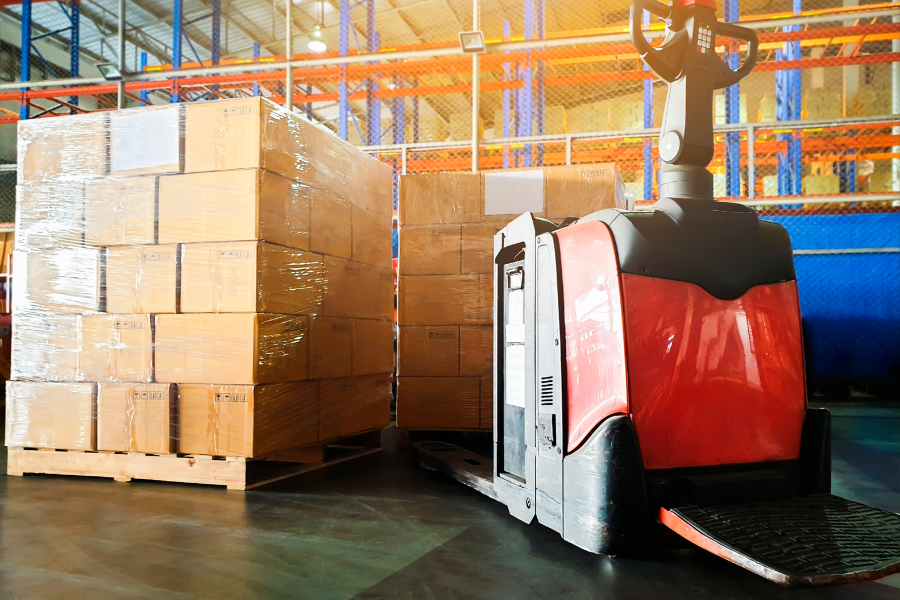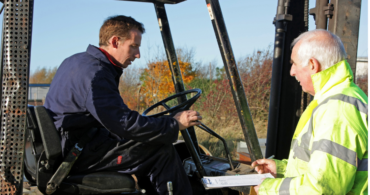The walkie rider forklift: it’s an extremely useful machine with a kind of silly name.
Words can be extremely silly. Some silly words are onomatopoeias, which sound like what they mean, for example, “buzz” and “gargle.” Some are just silly and fun to say, like “onomatopoeia.” Some words are so silly that they don’t even seem silly anymore because we’re so familiar with them that we overlook their silliness.
Take, for example, the walkie-talkie, developed during World War II so soldiers in the field could communicate with their commanders. These were men in some of the most extreme conditions of their lives as bullets and artillery shells rained around them. They looked at the device formally known as the “handheld transceiver” and agreed on “walkie-talkie” because they could walkie with it and talkie into it at the same time. Even better, the term “walkie-talkie” referred to a backpack radio. What most people tend to think of as a walkie-talkie today was originally called (and we’re not kidding) a “handie-talkie.”
That brings us to the useful dual functionality and silly moniker of the walkie rider pallet jack.
What is a pallet jack?
A manual pallet jack was one of the earliest types of forklifts. This device is relatively simple, consisting of two forks on wheels and a lever the operator uses to steer. To lift cargo, the operator guides the forks through a pallet and then pulls the lever back and forth, using it like a jack.
Most of these vehicles only lift loads a few inches off the ground. Pallet jacks are great for moving pallets a short distance or around a small warehouse as long as the intent is to store them low or on the floor.
Manual pallet jacks take a physical toll on operators because they need to push and pull loads. This is less of an issue over a short distance. However, as goods required transport over extended distances, manual pallet jacks became inefficient and needed to be modernized.
What is a walkie rider?
A walkie rider, also known as a Class III forklift (electric motor hand trucks and rider trucks), is an evolution of a manual pallet jack because an electric motor powers it. In addition to being able to travel longer distances, the electric motor enables a walkie rider pallet jack to navigate through tight spaces. It also contributes to smoother and more controlled movements, especially when transporting loads over longer distances. The front and load wheels (located at the back of the forks) also help to ensure stability, responsiveness and precise control.
A walkie rider pallet jack is an interesting machine because the name can be a little misleading. Some walkie riders are exclusively a pallet rider (also known as a rider jack) designed with a platform in the middle of the machine where the operator stands. Some walkie riders are exclusively walkies with electric propulsion and lifting but no platform, so the operator walks behind the machine. Finally, some are genuinely walkie riders (also adorably known as a ride on walkie) with the ability to steer while walkie-ing and the option to hop on a small platform and rider.
A walkie rider pallet jack is equipped with a hydraulic lifting mechanism, which allows the machine to lift heavier loads than many manual pallet jacks. To raise a pallet, the operator uses controls on the handle to engage the hydraulics. The load wheels provide stability and help distribute the weight of the load. The hydraulics also allow the operator to control the descent and smoothly lower the load.
Benefits of a walkie rider
By offering either walk-behind or ride-on capabilities (and sometimes both), the walkie rider pallet jack provides many material handling benefits.
Increased efficiency
The versatility of the walkie rider streamlines loading and unloading trucks, transporting goods through a warehouse and maneuvering through narrow aisles and tight turns. The machine’s ability to quickly adapt to a variety of needs can help to increase and improve overall operational productivity.
Versatility
A walkie rider is suited for a variety of applications, from easily maneuvering in confined spaces to convenient longer-distance transport. This adaptability is exceptionally valuable in warehouses where equipment needs to adjust to various material handling requirements.
Reducing operator fatigue
A walkie rider improves operator comfort and helps to reduce fatigue. The electric motor and ride-on platform (when available) minimize the physical strain on operators, especially over extended distances. This enhances the operators’ well-being and contributes to sustained productivity throughout the workday.
Make mine a double, a walkie double pallet jack, that is
Some of the walkie riders used in busy or large warehouses and distribution centers include a design variation that dramatically changes their functionality.
A double walkie is designed to lift and transport not one but two pallets simultaneously. A walkie double pallet jack has longer forks that can fit two pallets end-to-end. This essentially doubles operational efficiency and is a significant advantage when you need to move a large volume of goods quickly.
However, when you really want to move some cargo, a triple walkie may be the solution. A walkie triple pallet jack can handle three pallets at once, which is one more than two and three times as many as one. Double and triple walkie rider pallet jacks are typically electric-powered to effectively handle the increased load capacity. They are valuable tools in warehouses dealing with high volumes of goods, where reducing the number of trips is necessary to improve overall productivity.
Walkie rider safety precautions
It is essential to follow proper safety procedures to help ensure a secure and productive work area.
Inspect the equipment before using
Even a manual pallet jack is designed to carry pallets that are beyond the capacity of most humans to lift. This means any equipment failure could cause an accident and severe injury. It is crucial to carefully inspect the machinery before using any forklift. When inspecting a walkie rider pallet jack, look for loose prongs, unbalanced wheels, leaks, etc. It is advisable to use a pre-op checklist to ensure that nothing is missed during the inspection.
Check and double-check the route
Even with a walkie rider that does not lift pallets too high, cargo can obstruct the operator’s view and cause them to miss obstructions. Be sure to check the route for possible obstacles and clear them before advancing. You should also check the terrain and look for uneven surfaces that could impede your progress. If the surface is bad enough, you may need to find an alternate route.
Operator certification
The Occupational Safety and Health Administration (OSHA) requires that all manual or electric walkie rider operators complete a certification course before using the machine. It is the employer’s responsibility to ensure their workers are certified on the specific machines they use. Those who fail to acquire the appropriate certification can face significant fines and penalties.
Restrict access to the machines
In addition to confirming that all operators are certified, employers should also ensure that those are the only people operating the machines. One method is to restrict access to the walkie riders by storing them in a secure area. It is also recommended to have a check-out and check-in procedure. Even a paper sign-in sheet can provide a safeguard and ensure that only authorized users can access these machines.
At Texas Motive Solutions, we can help ensure that your walkie riders and all electric forklifts remain running at their peak performance. We have the forklift batteries and accessories to keep your fleet purring, and we provide a complimentary forklift fleet performance analysis to guarantee you have the correct batteries for your needs.
Give us a call at (888) 316-2459 or fill out this form to discover everything Texas Motive Solutions can do for you.


